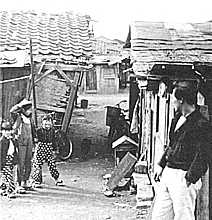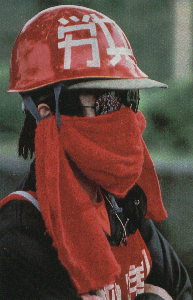Burakumin
 The burakumin,
which is literally defined as 'hamlet people', or buraku are another
exception to the homogeneity of the Japanese people. From the 14th century until
the middle of the 17th century the Japanese rulers had been creating a division
of people according to occupation. The buraku are most likely descended
from people who were defeated in earlier feudal wars or from people who ignored
traditional Buddhist tenets and so became defined as outcasts (or impure), particularly
during the early years of the Edo period (1603-1868) or feudal Middle Ages in
Japan. Those considered to be lesser artisans and cleaners among others, were
categorised as burakumin. They were treated as eta - extreme filth,
and hinin - nonhuman. They lived in settlements known as hisabetsu
buraku or 'discriminated hamlets'.
The burakumin,
which is literally defined as 'hamlet people', or buraku are another
exception to the homogeneity of the Japanese people. From the 14th century until
the middle of the 17th century the Japanese rulers had been creating a division
of people according to occupation. The buraku are most likely descended
from people who were defeated in earlier feudal wars or from people who ignored
traditional Buddhist tenets and so became defined as outcasts (or impure), particularly
during the early years of the Edo period (1603-1868) or feudal Middle Ages in
Japan. Those considered to be lesser artisans and cleaners among others, were
categorised as burakumin. They were treated as eta - extreme filth,
and hinin - nonhuman. They lived in settlements known as hisabetsu
buraku or 'discriminated hamlets'.
 However, the
buraku look like other Japanese people, but remain an underprivileged
minority, due to caste-like discrimination. Today, there are up to 6,000 burakumin
districts and between 1.2 to 2 million buraku in Japan (about 2% of the
population). The social practices of exclusion have resisted change. Discrimination
continues today, particularly in employment and marriage as well as in communicating
with public officials. Activists groups have sought change and protests have
occurred, especially where it is felt that the police target the burakumin
population and districts (which some describe as ghettos) on the basis that
law enforcement offices consider them to be inclined to criminal behaviour.
Such profiling is an awful bias which is being fought against.
However, the
buraku look like other Japanese people, but remain an underprivileged
minority, due to caste-like discrimination. Today, there are up to 6,000 burakumin
districts and between 1.2 to 2 million buraku in Japan (about 2% of the
population). The social practices of exclusion have resisted change. Discrimination
continues today, particularly in employment and marriage as well as in communicating
with public officials. Activists groups have sought change and protests have
occurred, especially where it is felt that the police target the burakumin
population and districts (which some describe as ghettos) on the basis that
law enforcement offices consider them to be inclined to criminal behaviour.
Such profiling is an awful bias which is being fought against.
Japanís elaborate system of 'family registers' which is a record of each personís
ancestry also makes it almost impossible for a buraku to conceal his
or her origins. Making it difficult to work for a major company or marry outside
the so-called caste. Parents routinely investigate the background of their childrenís
prospective marriage partners and a pending marriage may be broken up by strong
objections from a family member, if the partner is considered to be from the
burakumin. While discrimination is illegal, such attitudes and practices
still persist.
 Check
out this link for the Buraku Liberation and Human
Rights Research Institute Incorporated (BLHRRI) website. And click
here to read the interview Discrimination
From Both Sides of The Skin with Buraku Abolitionist Nadmoto Masahisa.
Check
out this link for the Buraku Liberation and Human
Rights Research Institute Incorporated (BLHRRI) website. And click
here to read the interview Discrimination
From Both Sides of The Skin with Buraku Abolitionist Nadmoto Masahisa.
 The burakumin,
which is literally defined as 'hamlet people', or buraku are another
exception to the homogeneity of the Japanese people. From the 14th century until
the middle of the 17th century the Japanese rulers had been creating a division
of people according to occupation. The buraku are most likely descended
from people who were defeated in earlier feudal wars or from people who ignored
traditional Buddhist tenets and so became defined as outcasts (or impure), particularly
during the early years of the Edo period (1603-1868) or feudal Middle Ages in
Japan. Those considered to be lesser artisans and cleaners among others, were
categorised as burakumin. They were treated as eta - extreme filth,
and hinin - nonhuman. They lived in settlements known as hisabetsu
buraku or 'discriminated hamlets'.
The burakumin,
which is literally defined as 'hamlet people', or buraku are another
exception to the homogeneity of the Japanese people. From the 14th century until
the middle of the 17th century the Japanese rulers had been creating a division
of people according to occupation. The buraku are most likely descended
from people who were defeated in earlier feudal wars or from people who ignored
traditional Buddhist tenets and so became defined as outcasts (or impure), particularly
during the early years of the Edo period (1603-1868) or feudal Middle Ages in
Japan. Those considered to be lesser artisans and cleaners among others, were
categorised as burakumin. They were treated as eta - extreme filth,
and hinin - nonhuman. They lived in settlements known as hisabetsu
buraku or 'discriminated hamlets'.
 However, the
buraku look like other Japanese people, but remain an underprivileged
minority, due to caste-like discrimination. Today, there are up to 6,000 burakumin
districts and between 1.2 to 2 million buraku in Japan (about 2% of the
population). The social practices of exclusion have resisted change. Discrimination
continues today, particularly in employment and marriage as well as in communicating
with public officials. Activists groups have sought change and protests have
occurred, especially where it is felt that the police target the burakumin
population and districts (which some describe as ghettos) on the basis that
law enforcement offices consider them to be inclined to criminal behaviour.
Such profiling is an awful bias which is being fought against.
However, the
buraku look like other Japanese people, but remain an underprivileged
minority, due to caste-like discrimination. Today, there are up to 6,000 burakumin
districts and between 1.2 to 2 million buraku in Japan (about 2% of the
population). The social practices of exclusion have resisted change. Discrimination
continues today, particularly in employment and marriage as well as in communicating
with public officials. Activists groups have sought change and protests have
occurred, especially where it is felt that the police target the burakumin
population and districts (which some describe as ghettos) on the basis that
law enforcement offices consider them to be inclined to criminal behaviour.
Such profiling is an awful bias which is being fought against.
